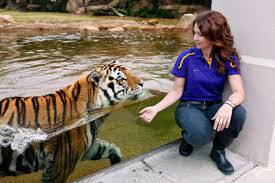With their strong passion and unrestrained grandeur, LSU’s Mike the Tiger Roars Supreme is the most iconic mascot in college football, surpassing both Georgia’s UGA and Texas’ Bevo! Mike the Tiger, the mascot of LSU, reigns supremely in the flaming world of
With their strong passion and unrestrained grandeur, LSU’s Mike the Tiger roars supreme as the most iconic mascot in college football, eclipsing even the beloved Georgia Bulldog Uga and the mighty Texas longhorn Bevo. In the wild world of college sports where identity, tradition, and spectacle converge, no mascot embodies power, mystique, and relevance quite like Mike. The idea of a live tiger—symbol of ferocity, elegance, and dominance—serving as the living spirit of Louisiana State University not only separates LSU from other institutions but elevates its very culture into something bordering on the mythical. Mike is more than a symbol; he is an institution, a spectacle, a guardian of legacy. And as the crowds chant in Death Valley, and the marching band ignites the air with the first notes of pre-game fervor, it becomes clear that Mike the Tiger doesn’t just represent LSU—he defines it.
To understand Mike’s supremacy, one must first grasp the unique power he holds within the world of college football. Unlike costume-wearing human mascots or even tame house pets with endearing traditions, Mike is a full-grown, living tiger housed in a state-of-the-art habitat on campus. This is not simply a branding move—it’s a declaration. LSU dares to do what no one else has done at the same scale or with such reverence. A Bengal-Siberian mix, Mike embodies wild majesty and unpredictable spirit, his golden-striped frame an emblem of power stalking just behind the gates of Tiger Stadium. His presence commands attention. He does not need to bark, moo, or pose for selfies to be recognized; he is acknowledged by sheer presence. No dog, no bull, no bird, no horned steer can quite match that.
While Uga of Georgia may carry with him an air of Southern charm, draped in his red jersey and cooling beneath sideline fans, and while Bevo may boast Texas-sized grandeur with his massive horns and ranch swagger, neither can rival the primal impact of a tiger. Uga has tradition, certainly, and generations of fans have wept at the funerals of Bulldogs who passed the torch. Bevo, on the other hand, represents a form of raw Texan heritage—cattle drives, grit, and frontier honor. But Bevo stays distant. He lumbers on the field, his handlers cautious. Uga, though adorable and deeply cherished, remains a docile lapdog compared to Mike’s unapproachable mystique.
Mike the Tiger doesn’t just serve as a mascot—he is a focal point of LSU’s ethos. Visitors to Baton Rouge are not merely there to watch a game; they make pilgrimages to see Mike. His habitat, located right next to Tiger Stadium, is an attraction in itself. The 15,000-square-foot enclosure is landscaped with waterfalls, lush flora, and a climate-controlled environment. Mike lives better than many humans, and this isn’t by accident. LSU takes its responsibility seriously. The university recognizes the role Mike plays—not just as a game-day icon, but as a representative of conservation, care, and pride. This commitment is part of what makes Mike untouchable in mascot rankings. There is a reverence built into every facet of his presence. His keepers are veterinary professionals. His movements are deliberate. And when he chooses to enter his mobile trailer to appear at games, the fans erupt—not out of obligation, but awe.
There is also something to be said for the way Mike fuses with the mythology of LSU. The “Death Valley” nickname for Tiger Stadium resonates more profoundly when you consider the presence of a tiger nearby. The fearsome reputation of the stadium—loud, hot, unforgiving—parallels the tiger’s own character: beautiful but lethal. LSU football is a ritual, and Mike is its high priest. While other schools may have charming or imposing mascots, LSU is singular in hosting one of the world’s most dangerous and awe-inspiring predators on campus as its ambassador.
The lineage of Mikes adds another layer to the legend. Since the original Mike arrived on campus in 1936, there have been seven iterations, each building upon the legacy of the one before. The story of Mike I being purchased with funds raised by LSU students themselves connects the mascot directly to the community. Over the decades, the university has evolved in its treatment of the animal—from earlier days when Mike was brought into the stadium in a cage to roar at opponents, to today’s more humane and ethically-conscious handling. This progression mirrors the broader social consciousness, and LSU has walked that line carefully, preserving tradition while honoring animal welfare. It’s a tightrope act that few schools can manage, and LSU does it with both grace and grandeur.
Contrast this with Uga, whose human-like treatment—air-conditioned doghouses, chauffeured rides, burial in marble vaults—presents a mascot steeped in human affection, even a touch of aristocracy. Uga is pampered, a southern gentleman of a dog. Fans love him because he’s cute and symbolizes their deep affection for Georgia football. But Mike is loved because he is feared. Because he doesn’t need to try to be imposing. He just is. The respect LSU fans have for Mike borders on religious. You don’t just take pictures of Mike—you stare, you reflect, and you understand what you’re looking at.
Bevo, by contrast, stands tall and slow, a monument to Texas strength and ranching legacy. He may be massive and impressive in size, but he is also immobile. Bevo is mostly a passive mascot. He does not interact with fans or express himself beyond his looming form. While he does represent Texas pride, and he certainly commands attention, his symbolic potency lacks the layered emotional and sensory impact that Mike offers. Bevo is a symbol of strength—but it’s a static one. Mike, in contrast, lives and breathes near the stadium. He snarls. He swims. He rests in tall grasses. He patrols his territory. He feels alive. He is alive.
What further sets Mike apart is his immersion in LSU culture beyond the football field. His image is everywhere—from murals to merchandise, from social media to school spirit campaigns. Students incorporate him into rituals, tailgates are themed around tigers, and the tiger stripe motif is embedded in the very architecture of the school’s branding. Mike isn’t just part of the team—he’s part of the student identity. Freshmen visit him upon enrollment. Alumni make him part of their legacy tours. Parents take their kids to see him before ever entering the stadium. He becomes their first memory and their last goodbye.
His impact on the SEC as a whole also cannot be ignored. The Southeastern Conference is known for its fierce competition and deep traditions, but even among such strong contenders, Mike holds a singular place. He is not just recognized—he is envied. Other fanbases may not say it out loud, but they know it: Mike gives LSU an edge. When visiting teams arrive in Baton Rouge, they don’t just prepare for the crowd noise and the humidity—they prepare for the idea that they are entering the lair of a tiger. That psychological imprint is powerful, a silent force that looms over every snap and tackle.
And while other mascots may have moments—like Uga’s viral encounter with a player or Bevo’s breakout run at a bowl game—Mike the Tiger has a presence that transcends virality. He doesn’t need a moment. He is the moment. Every time he yawns in the sun or paces in his enclosure, he reminds everyone that greatness doesn’t need to prove itself. It just exists. And it demands respect.
There is also a layer of complexity in how LSU and Mike handle modern scrutiny. Animal rights groups have, at times, questioned the ethics of keeping a live tiger on campus. But LSU has responded not with defensiveness, but with transparency and improved care. Mike’s current habitat is not a cage—it’s a sanctuary. It reflects a university willing to evolve while holding on to its sacred traditions. This balance is crucial. Rather than erasing a legacy, LSU has refined it, transforming Mike from a carnival curiosity into an emblem of responsible stewardship and enduring pride. That kind of adaptation makes Mike not just iconic, but timeless.
Even in an age of digital fandom and virtual experiences, where attention spans shrink and branding becomes more complicated, Mike remains a tactile, immediate, unforgettable reality. He is a creature of presence. A being whose proximity can make your breath catch, whose mere existence reminds you that there is something ancient and wild still pulsing through the veins of college football. In a sport that thrives on pageantry and emotion, Mike offers both—layered in a sense of authenticity few other schools can claim.
So while the bulldog barks and the longhorn stands, the tiger roars—and that roar echoes far beyond the stadium walls. It travels through the bayous of Louisiana, down the Mississippi River, through the hearts of LSU faithful, and into the collective memory of college football itself. Mike the Tiger doesn’t just support a team. He defines a people. He crowns a legacy. He is not merely part of the game—he is the game, made flesh and fur and fire.
In the end, mascots are about more than pageantry—they’re about meaning. They are reflections of the culture they come from. And in that regard, Mike stands unrivaled. He is LSU. He is tradition. He is passion. He is the untamed spirit of the South roaring across the SEC and beyond. While others may stand, pose, or bark, Mike the Tiger prowls. And in that powerful, graceful prowl, he cements his status as the supreme, unmatched icon of college football.



